|
|
|
|
|
Oil On
Canvas, Real Flavor of Old Masters
|
|

|
ARTWORKS
INDEX
A B C D E F G H I J K L M N O P Q R S T U V W X Y Z |
ARTISTS
INDEX
A B C D E F G H I J K L M N O P Q R S T U V W X Y Z |
|
|
| | |
|
|
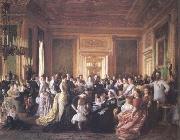 |
Laurits Tuxen -- Click Here
|
|
Danish Painter, 1853-1927
was a Danish painter specialising in figure painting. He was also associated with the Skagen group of painters. Tuxen grew up in Copenhagen and studied at the Royal Danish Academy of Art where together with P.S. Krøyer he was considered to be one of the best painters. He first visited Skagen in 1870 and he returned on several occasions. In the 1880s and 1890s, he travelled widely painting portraits for Europe's royal families including Christian IX of Denmark, Queen Victoria and the Russian royalty. In 1901, after the death of his first wife Ursule, he married the Norwegian Frederikke Treschow and shortly aferwards purchased Madam Bendsen's house at the artists' colony in Skagen in the north of Jutland, converting it into a stately summer residence. |
|
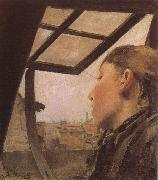 |
Laurits Andersen Ring -- Click Here
|
|
Danish, 1854-1933
Laurits Andersen Ring (1854-1933) was one of the foremost painters of Danish symbolism. He was born as Laurits Andersen in the village Ring in southern Zealand. In 1881 he the took the name of his birth place, and was since known as L.A. Ring.
For a while, he lived at Baldersbronde near Hedehusene in the old school building, which was later to be the home of another painter, Ludvig Find. Ring has produced several paintings from these towns.
As a painter, he never distanced himself from his humble origin, but rather made it his dominant theme. Most of his paintings depict the village life and landscapes of southern Zealand from Præsto to Nestved. There are several examples of his work at practically every Danish art museum including the Hirschsprung Collection in Copenhagen.
He was married on July 25, 1896 to fellow painter Sigrid Kahler, who was the daughter of ceramic artist Herman Kahler. |
|
|
|
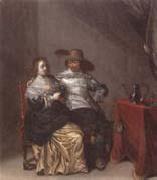 |
Laurentius de Neter -- Click Here
|
|
German , Born in Elbing circa 1600-1649
|
|
|
|
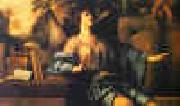 |
Laurent de la Hyre -- Click Here
|
|
1606-1656
French Laurent de la Hyre Galleries
He became a pupil of Georges Lallemand and studied the works of Primaticcio at Fontainebleau, but never visited Italy. La Hyre is associated with the transitional period before the introduction of the French Baroque by Simon Vouet.
His picture of Pope Nicholas V opening the crypt in which he discovers the corpse of St. Francis of Assisi standing (located at the Louvre) was executed in 1630 for the Capuchin friars of the Marais; its gravity and sobriety seems to have been influential for the next generation of French painters, particularly Eustache Le Sueur. The Louvre contains eight other works, and paintings by La Hyre are in the museums of Strasburg, Rouen and Le Mans.
Laurent de La Hyre: Perspective (drawing).His drawings, of which the British Museum possesses a fine example, Presentation of the Virgin in the Temple, are treated as seriously as his paintings, and sometimes show simplicity and dignity of effect. The example of the Capuchins, for whom he executed several other works in Paris, Rouen and Fecamp, was followed by the goldsmith's company, for whom he produced in 1635 St. Peter healing the Sick (Louvre) and the Conversion of St Paul in 1637. In 1646, with eleven other artists, he founded the French Royal Academy of Painting and Sculpture.
Richelieu called La Hyre to the Palais Royal; Pierre S??guier, Gedeon Tallemant des R??aux and many others entrusted him with important works of decoration; for the Gobelins he designed a series of large compositions. La Hyre painted also a great number of portraits, and in 1654 united in one work for the town-hall of Paris those of the principal dignitaries of the municipality. |
|
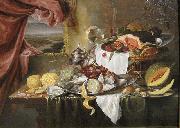 |
Laurens Craen -- Click Here
|
|
Laurens Craen (c. 1620, The Hague - c.1670, Middelburg ), was a Dutch Golden Age painter.
|
|
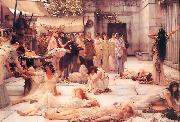 |
Laura Theresa Alma-Tadema -- Click Here
|
|
(1852 C 15 August 1909 in Hindhead) was from 1871 the second wife of the painter Lawrence Alma-Tadema and a painter in her own right.
A daughter of Dr George Napoleon Epps (who was brother of Dr John Epps), her two sisters were also painters (Emily studied under John Brett, a Pre-Raphaelite, and Ellen under Ford Madox Brown), whilst Edmund Gosse and Rowland Hill were her brothers-in-law. It was at Madox Brown's home that Alma-Tadema first met her in December 1869, when she was aged 17 and he 33. (His first wife had died in May that year.) He fell in love at first sight,and so it was partly her presence in London (and partly the fact that only in England had his work consistently sold) that influenced him into relocating in England rather than elsewhere when forced to leave the continent by the outbreak of the Franco Prussian War in July 1870. Arriving in London at the beginning of September 1870 with his small daughters and sister Artje, Alma-Tadema wasted no time in contacting Laura, and it was arranged that he would give her painting lessons. During one of these, he proposed marriage. As he was then thirty-four and Laura was now only eighteen, her father was initially opposed to the idea. Dr Epps finally agreed on the condition that they should wait until they knew each other better. They married in July 1871 and, though this second marriage proved childless, it also proved enduring and happy, with Laura acting as stepmother to her husband's children by his first marriage.
The Paris Salon in 1873 gave Laura her first success in painting, and five years later, at the Paris International Exhibition, she was one of only two English women artists exhibited. |
|
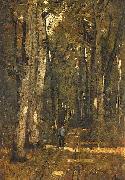 |
Laszlo Paal -- Click Here
|
|
Laszlo Paal (1846-1879) was a Hungarian Realist landscape painter. He was a pupil of Mihaly Munkacsy. His pictures are representative of lyrical realism: his oeuvre is related to the tendencies of the Barbizon School. |
|
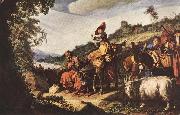 |
LASTMAN, Pieter Pietersz. -- Click Here
|
|
Dutch Baroque Era Painter, ca.1583-1633
Dutch painter and draughtsman. He was the son of the goldsmith Pieter Segersz. His older brother Seeger Pietersz. [Coninck] became a goldsmith like his father, while his younger brother Claes Lastman became an engraver and painter. Pieter trained as a painter under the Mannerist artist Gerrit Pietersz., brother of the composer Jan Pietersz. Sweelinck. In June 1602 Lastman travelled to Rome, like so many of his contemporaries. Van Mander, in his biography of Gerrit Pietersz., mentioned his pupil 'Pieter Lasman [sic] who shows great promise, being presently in Italy'. While there, Lastman made two drawings of an Oriental in a Landscape (both 1603; Amsterdam, Rijksmus.), which betray his continuing stylistic dependence on his master (as can also be seen in three drawings made before his trip to Italy). Related to the drawings made in Italy is a series of 12 prints after designs by Lastman of figures in Italian costumes (Hollstein, nos 11-22). Lastman also visited Venice, as is documented by a drawing (Cambridge, Fitzwilliam) after Veronese's Adoration of the Shepherds in the church of SS Giovanni e Paolo. Lastman was apparently in Italy until March 1607 but thereafter spent the rest of his life in Amsterdam. |
|
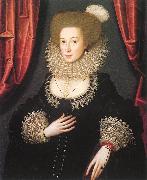 |
Larkin, William -- Click Here
|
|
British Painter, ca.1580-1619 |
|
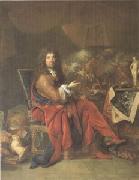 |
Largillierre -- Click Here
|
|
Paris 1656-1746
French painter. Following his early training in Antwerp and London, he established himself in Paris, becoming one of the most successful portrait painters of the second half of Louis XIV's reign. Although Largillierre was patronized by the Court, most of his sitters came from the wealthy middle classes; by the end of his career he had produced (by conservative estimates) some 1500 portraits. In 1734-5 and again in 1738-42 he was Directeur of the Academie Royale de Peinture et de Sculpture. |
|
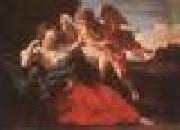 |
LANFRANCO, Giovanni -- Click Here
|
|
Italian painter (b. 1582, Parma, d. 1647, Roma).
Italian painter and draughtsman. A major figure in the development of the Roman Baroque in the 1620s, he painted many altarpieces and some cabinet pictures, but was notable above all for a number of dome frescoes that are indebted to the works of Correggio; most celebrated is the Assumption of the Virgin (1625-7) in the dome of S Andrea della Valle, Rome. He also influenced the development of art in Naples, where, between 1634 and 1646, he executed a series of vast fresco commissions that look forward to the art of Luca Giordano and Francesco Solimena. A vast number of Lanfranco's preparatory drawings survive, the majority of which are now in the Museo e Gallerie Nazionali di Capodimonte, Naples. Broadly speaking they are of two types: small (up to 200*250 mm) compositional sketches, either in brown pen, with or without brown wash, on white or beige fine paper, or in red chalk, sometimes with red wash, or, more rarely, in black chalk or a combination of both red and black; and slightly larger
|
|
 |
Landseer, Edwin Henry -- Click Here
|
|
RA (7 March 1802 - 1 October 1873) was an English painter, well known for his paintings of animalseparticularly horses, dogs and stags. The best known of Landseer's works, however, are sculptures: the lions in Trafalgar Square, London.
|
|
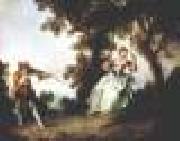 |
LANCRET, Nicolas -- Click Here
|
|
French painter (b. 1690, Paris, d. 1743, Paris).
French painter, draughtsman and collector. He was one of the most prolific and imaginative genre painters of the first half of the 18th century in France, and, although after his death he was long regarded as a follower and imitator of Antoine Watteau, his work is markedly personal and often innovative. He began training as an engraver but soon apprenticed himself to Pierre Dulin (1669-1748), a moderately successful history painter; by 1708 he had enrolled as a student at the Academie Royale de Peinture et de Sculpture, Paris. At an unknown date he entered the workshop of the genre and decorative painter Claude Gillot, who had been Watteau's master. This move signalled an important change of direction away from the history painting pursued by his friend Francois Lemoyne. Two contemporary biographers, Ballot de Sovot and D?zallier D'Argenville |
|
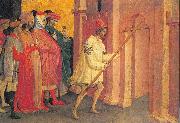 |
Lambertini, Michele di Matteo -- Click Here
|
|
Italian Painter, active 1416-1469 |
|
 |
Lambert, George -- Click Here
|
|
English Painter, ca.1700-1765
English painter. He was a pupil of Warner Hassels ( fl 1680-1710), a portrait painter in Godfrey Kneller's circle, but Lambert's earliest dated painting, Classical Landscape with Two Figures (1723; priv. col.), already shows the influence of the landscape painter John Wootton. From 1726 he worked in London as a scene painter at Lincoln's Inn Fields Theatre; he followed the impresario John Rich to Covent Garden Theatre in 1732 and continued to work there until his death. In 1735 he was a founder-member of the prestigious Beef-Steak Club, an association of actors, men of letters and artists, among them William Hogarth and Rich. |
|
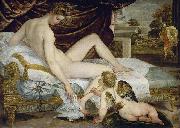 |
Lambert Sustris -- Click Here
|
|
(c. 1515-1520 - c. 1584) was a Dutch painter active mainly in Venice during the Mannerist style. He is also referred to as Alberto de Olanda (Albert of Holland). He was born in Amsterdam, and only came to Venice when over 40 years old. His training is unknown, but he was utilized by the studio of Titian for the depiction of landscapes. He accompanied Titian on his trips to Augsburg in 1548 and 1550 - 1551, and there executed portraits. Returning to Venice, he was influenced by Parmigianino and Andrea Meldolla. He was a teacher to Girolamo Muziano. His son was Friedrich Sustris.
|
|
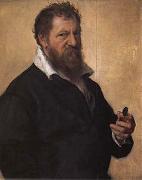 |
Lambert Lombard -- Click Here
|
|
Flemish Northern Renaissance Painter, 1505-1566
was a Renaissance painter, architect and theorist for the Prince-Bishopric of Liege. During his career he worked for Jan Gossaert in Middelburg and trained Frans Floris. In 1532 he became court painter and architect in Liege. A few paintings and many drawings have been preserved. In 1537 he was sent to Rome by Erard de la Marck, prince-bishop of Liege, to buy works of art, and he discovered the wonders of the Italian Renaissance. On his return he brought not only works of art, but also the new ideas concerning art and the position of the artist, to Liege. |
|
 |
Lambert Jacobsz -- Click Here
|
|
1598-1636
Dutch
Lambert Jacobsz Gallery
Dutch painter. He was the son of a well-to-do Mennonite cloth merchant in Amsterdam. He served his apprenticeship there among the artists now called the Pre-Rembrandtists. After his marriage in 1620, commemorated by the poet Joost van den Vondel (1587-1639), he settled in Leeuwarden, his wife's native city, where he became a preacher in the Mennonite community and worked primarily as a painter. He was also active as an art dealer, as is known from his estate inventory, which records transactions in Amsterdam with the Mennonite art dealer and patron of Rembrandt, Hendrick van Uylenburgh. Two of Jacobsz.'s pupils were Govaert Flinck and Jacob Backer. His son, the painter ABRAHAM VAN DEN TEMPEL probably also studied with him before becoming Backer's pupil c. 1642-6.
|
|
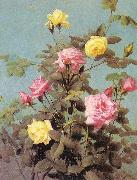 |
Lambdin, George Cochran -- Click Here
|
|
American Painter, 1830-1896
American painter. He was a son of the portrait and landscape painter James R. Lambdin (1807-89), who had founded a museum in Pittsburgh in 1828 and directed the Pennsylvania Academy of the Fine Arts in Philadelphia from 1845 to 1864. George Lambdin studied with his father and began exhibiting at the Pennsylvania Academy in 1848 and at the National Academy of Design, New York, in 1856. In the mid-1850s he travelled, probably to Munich, Paris and Rome. His early works were sentimental genre paintings, the best known of which are Our Sweetest Songs (1857; New York, N. Acad. Des.) and the Dead Wife (The Last Sleep) (exh. 1858; Raleigh, NC Mus. A.). The latter was shown at the Exposition Universelle in Paris in 1867 together with one of his depictions of a Civil War subject, Consecration, 1861 (1865; Indianapolis, IN, Mus. A.). In 1868-9 he was at the Tenth Street Studio Building, New York, where he continued to exhibit anecdotal genre, especially childhood subjects, as in The Pruner (1868; Boston, MA, Mus. F.A.). He was elected an Academician by the Pennsylvania Academy in 1863 and by the National Academy of Design in 1868. In Germantown, after a short trip abroad in 1870, Lambdin turned to floral studies, especially of roses from his own garden. Some of his floral still-life subjects were conventional table-top arrangements in glass or ceramic vases, but most were paintings of blooming plants and shrubs as they grow in nature or in garden pots, their foliage and blossoms silhouetted against blue sky or a neutral wall, as in Autumn Sunshine |
|
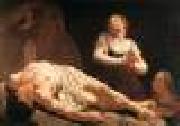 |
LAMA, Giulia -- Click Here
|
|
Italian painter, Venetian school (1681-1747). |
|
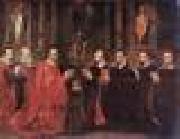 |
LALLEMANT, Georges -- Click Here
|
|
French painter (b. 1575/76, Nancy, d. 1636, Paris). |
|
|
|
 |
Lajos Deak-ebner -- Click Here
|
|
(1850- 1934 ) - Painter
painted On the Road in between 1876(1876) and 1880(1880)
|
|
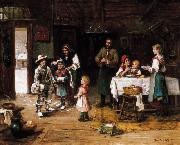 |
Lajos Bruck -- Click Here
|
|
painted Hazateres in 1910 |
|
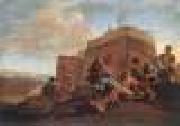 |
LAER, Pieter van -- Click Here
|
|
Dutch painter (b. 1592/95, Haarlem, d. 1642, Haarlem).
|
|
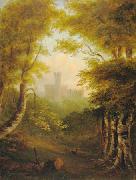 |
Lady Anne Barnard -- Click Here
|
|
(12 December 1750-6 May 1825), nee Anne Lindsay, eldest daughter of James Lindsay, 5th Earl of Balcarres was born at Balcarres House, Fife, Scotland. She was author of the ballad Auld Robin Gray and an accomplished travel writer, artist and socialite of the period. Her five year residence in Cape Town, South Africa, although brief, had a significant impact on the cultural and social life of the time. |
|
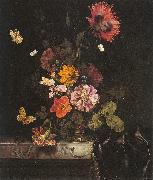 |
Lachtropius, Nicolaes -- Click Here
|
|
Dutch Baroque Era Painter, active 1656-1700 |
|
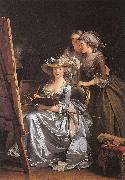 |
Labille-Guiard, Adelaide -- Click Here
|
|
French Neoclassical Painter, 1749-1803
French painter. Labille-Guiard was a painter of the French nobility before the Revolution and survived to paint the citizens of the Directory. Emerging from the 18th-century tradition of powdered wigs and shimmering satins, she captured informal moments in the lives of her subjects, frequently depicting them interrupted from some pastime |
|
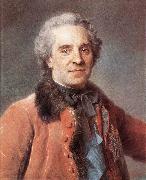 |
LA TOUR, Maurice Quentin de -- Click Here
|
|
French Rococo Era Painter, 1704-1788
French pastellist. He was one of the greatest pastellists of the 18th century, an equal of Jean-Simeon Chardin and Jean-Baptiste Perronneau. Unlike them, however, he painted no works in oils. Reacting against the stately portraits of preceding generations and against the mythological portraits of many of his contemporaries, La Tour returned to a more realistic and sober style of work. The fundamental quality of his art lies in his ability to suggest the temperament and psychology of his subjects by means of their facial expression, and thereby to translate their fugitive emotions on to paper: 'I penetrate into the depths of my subjects without their knowing it, and capture them whole', as he himself put it. His considerable success led to commissions from the royal family, the court, the rich bourgeoisie and from literary, artistic and theatrical circles. |
|
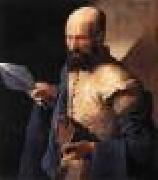 |
LA TOUR, Georges de -- Click Here
|
|
French Baroque Era Painter, 1593-1652
French painter. He was well known in his lifetime, especially for his depictions of candlelit subjects, then was forgotten until the 20th century, when the identification of works previously misattributed established his reputation as a giant of French painting. His early works were painted in a realistic manner and influenced by the dramatic chiaroscuro of Caravaggio. The paintings of La Tour's maturity are marked by a startling geometric simplification of the human form and by the depiction of interior scenes lit only by the glare of candles or torches. His religious paintings done in this manner have a monumental simplicity and a stillness that expresses both contemplative quiet and wonder. Little is known of his life, and only four or five of his paintings are dated. |
|
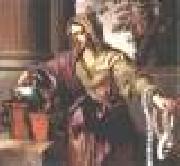 |
LA HIRE, Laurent de -- Click Here
|
|
French Baroque Era Painter, 1606-1656
|
|
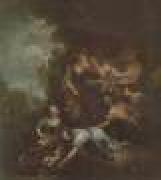 |
LA FOSSE, Charles de -- Click Here
|
|
French Baroque Era Painter, 1636-1716
French painter and draughtsman. He was the most important decorative painter in France in the generation after Charles Le Brun and in this capacity contributed to many of the major official and private building projects from the 1670s to the 1710s, including the D?me des Invalides in Paris and the chapel at the ch?teau of Versailles. His colourist's temperament, his early study of the Venetian painters of the 16th century and his interest in the work of Peter Paul Rubens contributed to the triumph of the party that championed colour over line and put him in the vanguard of the new tendency in French painting in the later 17th century. His work, with its rich and changing colours, combines the strength of the 17th century |
|
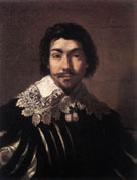 |
L ESTIN, Jacques de -- Click Here
|
|
French painter ,
b. 1597, Troyes, d. 1661, Troyes |
|
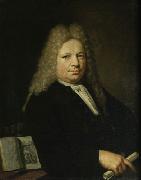 |
Krzysztof Lubieniecki -- Click Here
|
|
(1659-1729) was a Polish Baroque painter and engraver active in Amsterdam during the Dutch Golden Age.
Krzysztof was born in Szczecin. He and his brother Teodor Lubieniecki hailed from an Arian family. They learned to paint from Juriaan Stur in Hamburg. In 1667 they travelled to Amsterdam, where Krzysztof apprenticed with Adriaen Backer, and Teodor with Gerard de Lairesse. In 1682, Teodor moved to Hannover before eventually moving to Poland in 1706, where he died.
Krzysztof remained in Amsterdam, where he painted portraits and genre pieces. He also collaborated on prints for Jacobus Houbraken, Daniel Willink, and Johannes Brandt (son of Gerard Brandt). He died in Amsterdam.
|
|
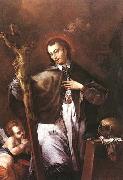 |
Kracker, Johann Lucas -- Click Here
|
|
Austrian painter
b. 1719, Wien, d. 1779, Eger |
|
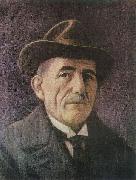 |
Kole Idromeno -- Click Here
|
|
Kolë Idromeno (1860-1939) was an Albanian painter, sculptor, photographer, architect and engineer.
He was born in Shkodër, where he learned the first elements of photography from Pietro Marubi. In 1876 he stayed for some months at the Academy of Fine Arts in Venice (Accademia di Belle Arti di Venezia), and then worked in the studio of an Italian painter. When back in Albania (1878), he engaged himself in a number of different activities, working as an architect, sculptor, photographer, scene-painter, engineer and painter. He was the initiator of the first art exhibition in Shkodër (1923) and was represented in the first national art exhibition in Tirana (1931).
He established a very active photographic studio. Idromeno was the first painter to show motion pictures in Albania in 1912. He had kept up a correspondence with the Lumiere brothers in Paris. |
|
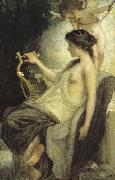 |
Karoly Lotz -- Click Here
|
|
(16 December 1833 - 13 October 1904) was a German-Hungarian painter.
Karl Lotz was born in Bad Homburg vor der Höhe, Germany, the 7th and youngest surviving child of Wilhelm Christian Lotz and Antonia Höfflick (Höfflich). His father was a valet of Prince Gustav zu Hessen-Homburg at the time when the prince was representing Austria at the Congress of Vienna, which among other matters dealt with the House of Hessen-Homburg's rights of sovereignty over Hessen-Darmstadt. The sudden death of the young Baron von Sinclair, charge d'affaires, forced W. C. Lotz temporarily into the rôle. While in Hungary in 1815 he made the acquaintance of the 13-year-old Antonie Hoefflich, whom he married three years later. She gave birth to 8 children, of whom Karl was the youngest.
W. C. Lotz died in 1837 and Antonie moved the family to Pest (now one of the three constituent parts of Budapest; the one on the east bank of the River Danube). Karl attended the Piaristengymnasium, where, although Calvinist, he was awarded a scholarship for his exceptional academic performance. He began his artistic career as a pupil of the Hofkapellmeister Destouches, then in the academy of the Venetian master Jacopo Marastoni (1804-1860). Later he was a pupil of the historical painters Henrik Weber (1818-1866) in Budapest and Carl Rahl (1812-1865) in Vienna.
Together with Rahl he worked on numerous commissions. Later he started on his own original works, first as a romantic landscape artist in scenes of the Alföld (the Hungarian lowland plain), and then as a creator of monumental murals and frescos in the style of the Venetian master Tiepolo.
After various works in Budapest he became active in Vienna. He laid out plans for a grandiose palace, and completed murals commissioned by the Abbot of Tihany for his abbey church on the shore of Lake Balaton. He became known for his portraits and nudes, for which both his wife and his daughters (Katarina in particular) posed. Lotz found married bliss only at the age of 58, when he married the widow Jacoboy, the former wife of his brother Paul Johann Heinrich, who had died in 1828. From then on he signed his works Keroly Jacoboy-Lotz.
In 1882 Lotz was appointed Professor at various art academies in Budapest, and in 1885 he became dean of a newly-established department for women painters. He was an honorary member of the Academy of Pictorial Arts in Vienna.
Tomb of Keroly Lotz by Jenos Pesztor (Kerepesi cemetery in Budapest)Hist last important public commission was the "Apotheosis of the Habsburg Dynasty", a huge ceiling fresco in the Habsburg Room of the newly rebuilt Royal Palace, that he painted in 1903, one year before his death. Lotz was already seriously ill when he worked on the fresco. The "Apotheosis" followed the traditions of Baroque court painting and the work was praised by contemporary critics. The fresco survived the war unscathed, but it was destroyed in the 1950s.
He died in 1904 in Budapest. As a "Prince of Hungarian Artists" he was given a state funeral and interred inside a memorial. His pictures, drawings and sketches were donated to the State of Hungary and are now in the Szepműveszeti Mezeum. Several Hungarian cities have streets named after him, there are Hungarian stamps bearing his likeness, and there is a bust in the National Museum in Budapest.
|
|
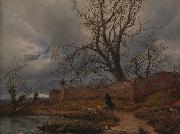 |
Karl Julius von Leypold -- Click Here
|
|
German, 1805-1874 |
|
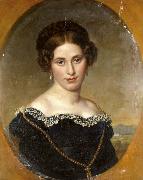 |
Karl Jakob Theodor Leybold -- Click Here
|
|
painted Portrait of a young woman in 1822 |
|
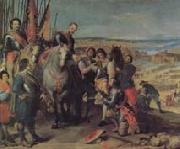 |
Jusepe Leonardo -- Click Here
|
|
Spanish Baroque Era Painter , 1601-c.1652 |
|
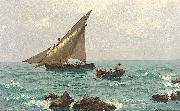 |
Julius Ludwig Friedrich Runge -- Click Here
|
|
painted Morgenstimmung an der Adria mit Fischerbooten und Langustenfischern. Im Vordergrund felsige Kuste in |
|
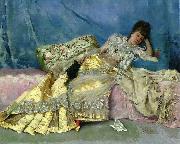 |
Julius LeBlanc Stewart -- Click Here
|
|
(September 6, 1855, Philadelphia, Pennsylvania - January 5, 1919, Paris, France), was an American artist who spent his career in Paris. A contemporary of fellow expatriate painter John Singer Sargent, Stewart was nicknamed "the Parisian from Philadelphia."
His father, the sugar millionaire William Hood Stewart, moved the family to Paris in 1865, and became a distinguished art collector and an early patron of Fortuny and the Barbizon artists. Julius studied under Eduardo Zamacois as a teenager, under Jean-Leo Grôme at the École des Beaux Arts, and later was a pupil of Raymondo de Madrazo.
Stewart's family wealth enabled him to live a lush expatriate life and paint what he pleased, often large-scaled group portraits. The first of these, After the Wedding (1880), showed the artist's brother Charles and his bride Mae, daughter of financier Anthony J. Drexel, leaving for their honeymoon. |
|
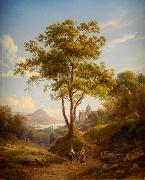 |
Julius Lange -- Click Here
|
|
(1817 -1878 ) - Painter
|
|
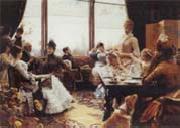 |
Julius L.Stewart -- Click Here
|
|
American Painter, 1855-1919
American artist, was born in Philadelphia. His father, William Hood Stewart, was a distinguished collector of the fine arts, an early patron of Fortuny and the Barbizon artists, and lived in Paris during the latter part of his life. The son was a pupil of JL Gerome, at the Ecole des Beaux Arts, and of Raymondo de Madrazo. Among his principal paintings are The Hunt Ball, Essex Club, Newark, New Jersey. |
|
 |
Jules Lefebvre -- Click Here
|
|
Tournan-en-Brie, 1834-Paris 1912.
French Academic Painter. |
|
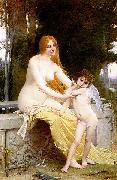 |
Jules Joseph Lefebvre -- Click Here
|
|
(Tournan-en-Brie, Seine-et-Marne, 14 March 1836 - Paris, 24 February 1911) was a French figure painter.
Lefebvre entered the École nationale superieure des Beaux-Arts in 1852 and was a pupil of Leon Cogniet. He won the prestigious Prix de Rome in 1861. Between 1855 and 1898, he exhibited 72 portraits in the Paris Salon. In 1891, he became a member of the French Academie des Beaux-Arts.
He was an instructor at the Academie Julian in Paris. He is chiefly important as an excellent and sympathetic teacher who numbered many Americans among his 1500 or more pupils. Some of his famous students were the Scottish-born landscape painter William Hart, as long as Georges Rochegrosse, Felix Vallotton, and many more. He was long a professor at the École des Beaux-Arts.
Many of his paintings are single figures of beautiful women.
Among his best portraits were those of M. L. Reynaud and the Prince Imperial (1874). Among his many decorations were a first-class medal at the Paris Exhibition of 1878 and the medal of honor in 1886. He was a Commander of the Legion of Honor and a member of the Institut de France.
|
|
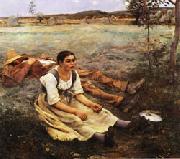 |
Jules Bastien-Lepage -- Click Here
|
|
French Realist Painter, 1848-1884
French painter. Bastien-Lepage grew up on a farm. Although his earliest efforts in drawing were encouraged, his parents violently objected when he decided to become a professional artist. To mollify them he worked for a time as a postal clerk in Paris while studying at the Ecole des Beaux-Arts. In 1868 he left the civil service and was accepted into Alexandre Cabanel's atelier. During this apprenticeship, Bastien-Lepage won two prizes in drawing, and in 1870 he made his d?but at the Salon with a Portrait of a Young Man (untraced). In the Franco-Prussian War (1870-71) he joined a regiment of sharpshooters and was severely wounded in the chest. When he recovered he attempted unsuccessfully to find work as an illustrator. |
|
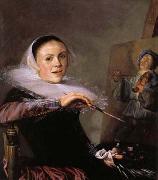 |
Judith leyster -- Click Here
|
|
1609-60
Dutch painter. She painted genre scenes, portraits and still-lifes, and she may also have made small etchings; no drawings by her are known. She specialized in small intimate genre scenes, usually with women seated by candlelight, and single half-length figures set against a neutral background. |
|
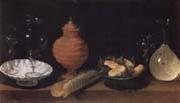 |
Juan van der Hamen y Leon -- Click Here
|
|
Spanish Baroque Era Painter, 1596-1631, was a Spanish painter, a master of the still life paintings, also called bodegones. During his lifetime, he was prolific and versatile, painting allegories, landscapes, and large-scale works for churches and convents. However, today he is remembered mostly for his still lifes. In the 1620s, He popularized still life painting in Madrid.Juan van der Hamen y (Gemez de) Leen was born in Madrid in 1596 but he was baptized late on April 8, 1596 in Madrid, therefore, he must had been born there just days before that date. He was the son of Jehan van der Hamen, a Flemish courtier, who had moved to Madrid from Brussels before 1586, and Dorotea Whitman Gemez de Leen, a half-Flemish mother of noble Toledan ancestry [1]. Van der Hamen and his two brothers Pedro and Lorenzo (both of whom were writers) emphasized their Spanish roots by using all or part of their maternal grandmother's family name, Gemez de Leen.. The painter's father, Jan van der Hamen, had come to Spain, as an archer, to the court of Philip II were he settled, married, and his children were born. According to 18th-century sources, the artist's father had also been a painter, but there is no evidence for this. Juan van der Hamen inherited his father's honorary positions at court and also served as unsalaried painter of the king. Van der Hamen's artistic activity in the service of the crown is first recorded on 10 September 1619, when he was paid for painting a still-life for the country palace of El Pardo, to the north of Madrid. |
|
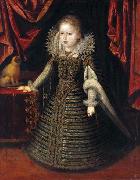 |
Juan Pantoja de la Cruz -- Click Here
|
|
(Valladolid, 1553 - 26 October 1608, Madrid) Spanish painter, one of the best representatives of the Spanish school of court painters. He worked for Philip II and Philip III. The Museo del Prado contains examples of his severe portraiture style.
Juan Pantoja de La Cruz was, born 1553 in Valladolid. Very little is known of his formative years as a painter. He was a pupil of the court painter Alonso Senchez Coello in Madrid and he must have assisted his master in complying with his duties as painter of the Spanish King, Philip II. Pantoja probably continued to work in his master studio after completing his training. He married in 1585 beginning to paint for the court around that time. After Sanchez Coello's death in 1588, Pantoja took over his master workshop and became court painter to Philip II of Spain.
Pantoja kept working for the court and the nobility, painting portraits of Prince Philip, the future Philip III, in 1592 and 1594. Among his most well known works is the portrait of Philip II wearing a cape and hat all in black, painted around 1594 for the Escorial. This portrait is one of the best representations of the idea of Spanish majesty, based on the remoteness of the monarch. On Philip II's death in 1598, Philip III confirmed Pantoja's status as court painter. When the court settled in Valladolid in 1601, Pantoja moved to the new capital, remaining in this city, several years. |
|
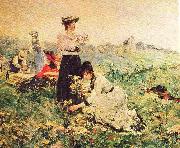 |
Juan Luna -- Click Here
|
|
Juan Luna y Novicio (October 23, 1857 - December 7, 1899) was an Ilocano Filipino painter, sculptor and a political activist of the Philippine Revolution during the late 19th century. He became one of the first recognized Philippine artists.
His winning the gold medal in the 1884 Madrid Exposition of Fine Arts, along with the silver win of fellow Filipino painter Felix Resurreccien Hidalgo, prompted a celebration which was a major highlight in the memoirs of members of the Propaganda Movement, with the fellow Ilustrados toasting to the two painters' good health and citing their win as evidence that Filipinos and Spaniards were equals.
Regarded for work done in the manner of the Spanish and French academies of his time, Luna painted literary and historical scenes, some with an underscore of political commentary. |
|
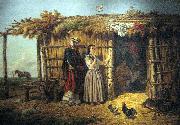 |
Juan Leon Palliere -- Click Here
|
|
painted Idilio criollo in c. 1861
|
|
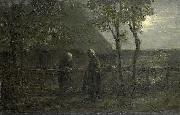 |
Jozef Israels -- Click Here
|
|
(27 January 1824, Groningen - 12 August 1911, Scheveningen) was a Dutch painter, and "the most respected Dutch artist of the second half of the nineteenth century". |
|
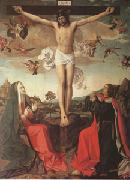 |
Josse Lieferinxe -- Click Here
|
|
active in Provence 1493-1505/08
was a South Netherlandish painter, formerly known by the pseudonym the Master of St. Sebastian. Originating in the diocese of Cambrai in Hainaut, then part of the territories ruled by the Dukes of Burgundy. Josse Lieferinxe was documented as a "Picard" in the regions of Avignon and Marseille at the end of the fifteenth and in the early sixteenth centuries. He was first mentioned in Provence in 1493. Thus he figures among the painters of the Provençal school, whose most prominent members in an earlier generation had also been from the far north of the French-speaking world Barth lemy d'Eyck and Enguerrand Quarton. In 1503 he married Michelle, a daughter of Jean Changenet, the most prominent painter of Avignon, in whose atelier Lieferinxe may have matured his style. He was last mentioned living in 1505, and in 1508 as deceased. Before he was identified by Charles Sterling who linked his work with a document, his artistic personality was recognized, as the "Master of St. Sebastian", through a former retable of eight scenes depicting the acts and miracles of Saint Sebastian and Saint Roch, protectors against the plague, which was commissioned in 1497 for the church of Nôtre Dame des Accoul's in Marseille. Bernardino Sismondi, who originally received the commission, died, however, before he could finish the work. |
|
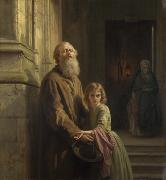 |
Josephus Laurentius Dyckmans -- Click Here
|
|
painted The Blind Beggar in 1853
|
|
 |
joseph-Louis-Hippolyte Bellange -- Click Here
|
|
b.1800-d.1866 |
|
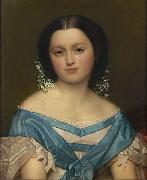 |
Joseph van Lerius -- Click Here
|
|
painted Portrait of Henriette Mayer van den Bergh in 1857 |
|
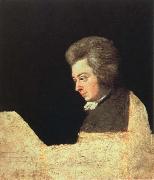 |
joseph lange -- Click Here
|
|
Joseph Lange (1 April 1751 W??rzburg - 17 September 1831 Vienna) was an actor and amateur painter of the 18th century. Through his marriage to Aloysia Weber, he was the brother-in-law of Wolfgang Amadeus Mozart. |
|
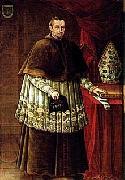 |
Jose Legarda -- Click Here
|
|
painted Portrait of Manuel de Alday, bishop of Santiago de Chile in 1772 |
|
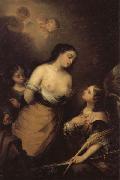 |
Jose Gutierrez De La Vega -- Click Here
|
|
Spanish , 1791-1865
|
|
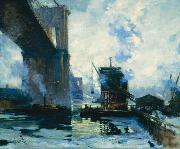 |
Jonas Lie -- Click Here
|
|
Jonas Lauritz Idemil Lie (6 November 1833 - 5 June 1908) was a Norwegian novelist, poet, and playwright who is considered to have been one of the Four Greats of 19th century Norwegian literature, together with Henrik Ibsen, Bjornstjerne Bjørnson and Alexander Kielland. |
|
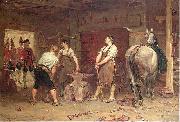 |
John Seymour Lucas -- Click Here
|
|
(21 December 1849 - 8 May 1923) was a Victorian English historical and portrait painter as well as an accomplished theatrical costume designer. He was born into an artistic London family, and originally trained as a woodcarver, but turned his attention to portrait painting and entered first the St. Martin's Lane Art School and later the Royal Academy Schools. Here he met his French wife, fellow artist Marie Cornelissen, whom he married in 1877. Lucase artistic education included extensive travels around Europe, particularly Holland and Spain, where he studied the Flemish and Spanish Masters. He first started exhibiting in 1872, was elected an associate member of the Royal Academy in 1876 and a full Royal Academician in 1898.
John Seymour Lucas was first and foremost a historical genre painter with a particular talent for realism in the depiction of costumes and interiors. Inspired by van Dyck and particularly Diego Velezquez, he excelled in depicting scenes from the English 16th to 18th century Tudor and Stuart periods, including in particular the Spanish Armada, Preparing for the Voyage, the English Civil War and the Jacobite rebellions.
His first major work to achieve widespread public acclaim was Rebel Hunting after Culloden, executed in 1884. It was praised not only for the obvious tension between the muscular blacksmiths and the redcoated forces of law and order (or repression) but for the extraordinary realism in the depiction of the rough smithy and glowing horsehoe on the anvil. In 1885 his next major work whas "Preparing for the Voyage".
As his reputation grew, Lucas increasingly mixed in society circles, and became firm friends with the famous society portrait painter John Singer Sargent who was his almost exact contemporary. A portrait of Lucas executed by John Singer Sargent is displayed in Tate Britain. Towards the 1890s John Seymour Lucas executed a number of major works for prestigious public buildings or royal clients. These include: The Flight of the Five Members (Houses of Parliament), The Granting of the Charter of the City of London (Royal Exchange), Reception by HM King Edward VII of the Moorish Ambassador (Royal Collection), HRH the Prince of Wales in German Uniform (Royal Collection)
Apart from executing over 100 major oil paintings and a host of drawings, Lucas was renowned as a set and costume designer for the historical dramas popular on the late Victorian and early Edwardian stages. One of his more unusual commissions was the "Duke of Normandy" costume for the ill-fated prince Alfred of Saxe Coburg-Gotha for the Devonshire House Ball in 1897. Lucas was also a prolific watercolour painter and was elected a member of the Institute of Painters in Water Colours in 1877.
During most of his artistic career, John Seymour Lucas lived in a purpose-built studio in South Hampstead, London, designed for him by his friend and fellow artist, architect Sydney Williams-Lee.
He retired from painting towards the end of World War I, and moved to Blythburgh, Suffolk, where re-designed a house next to the church known as 'The Priory'. Lucas died in 1923 and is interred in Blythburgh church yard. His son, Sydney Seymour Lucas, was also an artist, and illustrator.
|
|
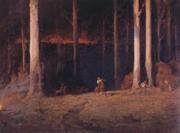 |
John Longstaff -- Click Here
|
|
Australian war artist, 1862-1941 |
|
|
|
|
|
|
|
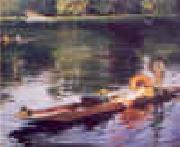 |
John Lavery -- Click Here
|
|
1856-1941
Sir John Lavery (20 March 1856 ?C 10 January 1941) was an Irish painter best known for his portraits.
Belfast-born John Lavery attended the Haldane Academy in Glasgow, Scotland, in the 1870s and the Acad??mie Julian in Paris in the early 1880s. He returned to Glasgow and was associated with the "Glasgow School". In 1888 he was commissioned to paint the state visit of Queen Victoria to the Glasgow International Exhibition. This launched his career as a society painter and he moved to London soon after. In London he became friendly with James McNeill Whistler and was clearly influenced by him.
Like William Orpen, Lavery was appointed an official artist in the First World War. Ill-health, however, prevented him from travelling to the Western Front. A serious car crash during a Zeppelin bombing raid also kept him from fulfilling this role as war artist. He remained in Britain and mostly painted boats, planes and airships. During the war years he was a close friend of the Asquith family and spent time with them at their Sutton Courtenay Thames-side residence, painting their portraits and idyllic pictures like Summer on the River (Hugh Lane Gallery).
After the war he was knighted and in 1921 he was elected to the Royal Academy. During this time, he and his wife both became interested in their Irish heritage and were tangentially involved in both the Irish War of Independence and the Irish Civil War: they gave the use of their London home to the Irish negotiators during the Treaty negotiations. After Michael Collins was killed, Lavery painted Michael Collins, Love of Ireland, now in the Hugh Lane Municipal Gallery.
In 1929 John Lavery made substantial donations of his work to both The Ulster Museum and the Hugh Lane Municipal Gallery and in the 1930s he returned to Ireland. He received honorary degrees from the University of Dublin and Queen's University of Belfast. He was also made a free man of both Dublin and Belfast.
He died in County Kilkenny, aged 84, from natural causes. He was buried in Putney Vale Cemetery. |
|
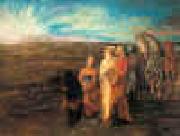 |
John La Farge -- Click Here
|
|
1835-1910
John La Farge (March 31, 1835 ?C November 14, 1910) was an American painter, stained glass window maker, decorator, and writer.
Born in New York City, New York, his interest in art was aroused during his training at Mount St. Mary's University and St. John's College (now Fordham University). He had only the study of law in view until he returned from his first visit to Paris, France where he studied with Thomas Couture and enjoyed the most brilliant literary society of the day. Even his earliest drawings and landscapes, done in Newport, Rhode Island, after his marriage in 1861 to Margaret Mason Perry, sister-in-law of Lilla Cabot Perry, show marked originality, especially in the handling of color values, and also the influence of Japanese art, in the study of which he was a pioneer.
La Farge's inquiring mind led him to experiment with color problems, especially in the medium of stained glass. He succeeded not only in rivaling the gorgeousness of the medieval windows, but in adding new resources by his invention of opalescent glass and his original methods of superimposing and welding his material. Among his many masterpieces are the "Battle Window" at Harvard and the cloisonn?? "Peacock Window" in the Worcester Art Museum. Two of his largest windows are located in Unity Church in North Easton, Massachusetts. The earliest of these, the "Angel of Help" was completed in 1887 while the "Figure of Wisdom" dates to 1901. Both of these windows were restored by "Victor Rothman for Stained Glass Inc" of Yonkers, New York in the 1990's.
Between 1859 and 1870, he illustrated Tennyson's Enoch Arden and Robert Browning's Men and Women. Breadth of observation and structural conception, and a vivid imagination and sense of color are shown by his mural decorations. His first work in mural painting was done in Trinity Church, Boston, in 1873. Then followed his decorations in the Church of the Ascension (the large altarpiece) and St. Paul's Church, New York. For the State Capitol at St. Paul he executed, in his seventy-first year, four great lunettes representing the history of religion, and for the Supreme Court building at Baltimore, a similar series with Justice as the theme. In addition there are his vast numbers of other paintings and water colors, notably those recording his extensive travels in the Orient and South Pacific.
His labors in almost every field of art won for him from the French Government the Cross of the Legion of Honor and membership in the principal artistic societies of America, as well as the presidency of the Society of Mural Painters. Enjoying an extraordinary knowledge of languages (ancient and modern), literature, and art, by his cultured personality and reflective conversation he greatly influenced all who knew him. Though naturally a questioner he venerated the traditions of religious art, and preserved always his Catholic faith and reverence.
In 1904, he was one of the first seven chosen for membership in the American Academy of Arts and Letters. On his passing in 1910, John LaFarge was interred in the Green-Wood Cemetery in Brooklyn, New York. During his life, he maintained a studio at 51 West 10th Street, in Greenwich Village, which today is part of the site of Eugene Lang College |
|
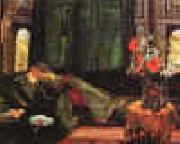 |
John Frederick Lewis -- Click Here
|
|
1805-1876
British
John Frederick Lewis Gallery
John Frederick Lewis (July 14, 1805 ?C August 15, 1876) was an Orientalist English painter. He specialized in Oriental and Mediterranean scenes and often worked in exquisitely detailed watercolour. He was the son of Frederick Christian Lewis (1779-1856), engraver and landscape-painter.
Lewis lived in Spain between 1832 and 1834. He lived in Cairo between 1841 and 1850, where he made numerous sketches that he turned into paintings even after his return to England in 1851. He lived in Walton-on-Thames until his death.
Lewis became an Associate of the Royal Academy (ARA) in 1859 and a member (an RA) in 1865.
After being largely forgotten for decades, he became extremely fashionable, and expensive, from the 1970s and good works now fetch prices into the millions of dollars or pounds at auction. |
|
|
|
 |
John Dalbiac Luard -- Click Here
|
|
LD 1872-1944 Nationality: English |
|
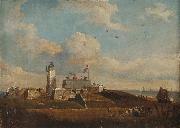 |
John Berney Ladbrooke -- Click Here
|
|
United Kingdom (1803 -1879 ) - Painter
|
|
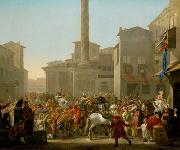 |
Johannes Lingelbach -- Click Here
|
|
(Frankfurt, 1622 - Amsterdam - 1674), was a Dutch Golden Age painter, associated with the second generation of Bambocciate, a group of genre painters working in Rome from 1625 - 1700.
|
|
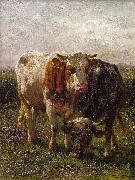 |
Johannes Hubertus Leonardus de Haas -- Click Here
|
|
(25 March 1832 - 4 August 1908) was a Dutch animal and landscape painter, and a peripheral figure of the Hague School.
Born at Hedel, De Haas spend his youth in Amsterdam where he got his first art education at evening-classes at the Koninklijke Academie. Consequently he moved to Haarlem where he was apprenticed to the artist Pieter Frederik van Os. During his stay in Haarlem he befriended Paul Gabriël and Hendrik Dirk Kruseman Van Elten who were also studying with Van Os.
In 1853, together with his two friends, De Haas decided to go to Oosterbeek. Here they came into contact with the influential landscape painter Johannes Warnardus Bilders and the group of painters which had gathered around him, many of whom would later be part of the Hague School. De Haas also met his future wife in Oosterbeek, Bilders' daughter, Caroline. In 1855 he received good reviews for his pictures that were exhibited in Paris from the noted art critic Jean Baptiste Gustave Planche.
In 1857 De Haas first went to Brussels, where he became friends with Willem Roelofs. De Haas frequently returned to the Netherlands and Oosterbeek for inspiration and Caroline. From 1860 his friend Gabriël also lived in Brussels, and De Haas often painted cattle in the landscapes of both Roelofs and Gabriel, fitting in perfectly with both their styles. In 1860 he won the gold medal at the exhibition of Utrecht.
From 1861 until 1869 De Haas is permanently settled in Brussels, painting mainly on the coasts of Flanders and Picardie in northern France. He married Caroline Bilders in 1862, and in 1864 they are briefly joined by her brother, the promising painter Gerard Bilders. In 1865 Caroline dies at the age of 24 of tuberculosis, leaving him with a young son. During his stay in Brussels De Haas is instrumental in passing on the style of the Barbizon school to the painters at Oosterbeek.
|
|
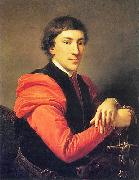 |
Johann-Baptist Lampi the Elder -- Click Here
|
|
painted Portrait of Paweł Grabowski. in1790 |
|
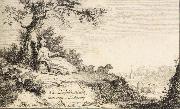 |
Johann Ludwig Aberli -- Click Here
|
|
Swiss, 1723-1786, Swiss painter, draughtsman and engraver. In 1741 he moved to Berne, where he took drawing lessons with Johann Grimm (1675-1747), whose school of drawing he took over in 1747. He visited the Bernese Oberland with Emanuel Handmann, Christian Georg Schetz (1718-91) and Friedrich Wilhelm Hirt (1721-72) in 1759 and in the same year travelled to Paris with Adrian Zingg (1734-86). This was his only trip abroad, but it determined him to work exclusively as a landscape painter. After nine months he returned to Berne, where his landscape views became popular, particularly with foreign travellers, enamoured of 'Nature' and keen to retain souvenirs of their travels. He was one of the first artists to portray the beauties of the Swiss countryside; his favourite subjects were the Aare Valley and views of Swiss lakes (e.g. View of Erlach on the Lake of Biel; Berne, Kstmus.). He invented a technique known as the 'Aberli style', which consisted of watercolour washes added to an image in which slightly smudged outlines were achieved through a combination of engraving and etching. The prints were made from drawings taken from nature and finished in the studio. His style was characterized by delicate execution, an intimate narrative approach, refined colours and the ability to convey a light and vaporous atmosphere. Aberli's success was such that he had to employ assistants and pupils to aid him in the coloration process; his pupils included Erasmus Ritter, Johann Jakob Biedermann, Marquard Wocher (1760-1830), Gabriel Ludwig Lory the elder (1763-1840) and Peter Birmann. From 1773 to 1775 Aberli also painted a series of costumes in response to tourist demand. |
|
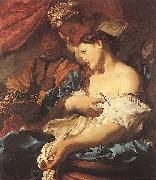 |
Johann Liss -- Click Here
|
|
Also called Jan Lys, (c. 1590 or 1597 - 1627 or 1631) was a leading German Baroque painter of the 17th century, active mainly in Venice.
Liss was born in Oldenburg (Holstein) in Schleswig-Holstein, Germany. After an initial education in his home state, he continued his studies, according to Houbraken, with Hendrick Goltzius in Haarlem and Amsterdam. Around 1620 he travelled through Paris to Venice. He moved to Rome around 1620?C1622, and his first works there were influenced by the style of Caravaggio.
Although his earlier work was concerned with the contrasts of light and shadow, his final move to Venice in the early 1620s modified his style and gave impetus to brilliant color and a spirited treatment of the painted surface.In 1627, he was created an admired large altarpiece, the Inspiration of Saint Jerome in San Nicole da Tolentino. His loose brushstrokes seem precursor to rococo styles of Guardi brothers.This final style, along with that of other "foreign" painters residing in Venice, Domenico Fetti and Bernardo Strozzi, represent the first inroads of Baroque style into the republic.
Liss fled to Verona to escape the Plague spreading in Venice, but succumbed there prematurely in 1629. According to Houbraken, he worked day and night on his paintings, so that Joachim von Sandrart felt that his health was at risk and urged him to join him in Rome
|
|
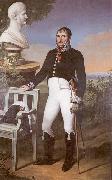 |
Johann Jakob de Lose -- Click Here
|
|
Johann Jakob de Lose (1755 - 1813), German painter, working in Frankfurt/Main. |
|
|
|
|
| | |
|
|
|
|